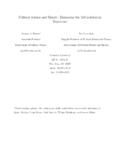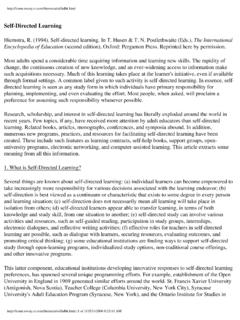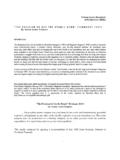Transcription of Electric Bus Analysis for New York ... - Columbia …
1 Electric Bus Analysis for New York City Transit Image by AEMoreira042281. By Judah Aber Columbia University May 2016. Background New York City Transit has requested an Analysis comparing the current fleet of buses to Electric buses. The current fleet of buses consists primarily of diesel and hybrid diesel buses, plus some CNG buses. The Analysis will center on the economics (financials) of the Electric bus alternative as well as on the environmental considerations (greenhouse gas emissions and air pollution). In addition, there will be consideration of potential implementation requirements, issues and recommendations. ABSTRACT. NYC Transit and MTA bus have a combined fleet of about 5,700 buses for public transportation in New York City. The fleet currently consists of a mix of diesel, hybrid diesel and CNG. (compressed natural gas) buses. Electric buses have vastly lower greenhouse gas (GHG) emissions than the current fleet. Changing the entire fleet of buses to Electric buses would result in a reduction of emissions within the city of approximately 575,000 metric tons of CO2e per year.
2 The net savings, including the incremental power generation required for the Electric buses is nearly 500,000 metric tons of CO2e assuming the current mix of power generation in New York City and Westchester (EPA). From a financial perspective, the savings associated with fuel (cost of diesel vs. cost of electricity) and with bus maintenance more than offsets the higher cost of Electric buses including the cost of the recharging infrastructure over the lifetime of a bus. Typically, Electric buses cost about $300k more than diesel buses, and annual savings are estimated at $39k per year over the 12-year lifetime of the bus, excluding health care cost benefits. Switching to Electric buses eliminates the air pollution caused by diesel bus fuel combustion. The resulting health benefit to the populous of the city from the reduction of respiratory and other diseases is estimated at $150k per bus based on EPA data. When applied to the financial case, the $150k improvement makes the case more compelling, and the health benefits should be a key consideration in the decision to switch to the new technology.
3 The MTA will have challenges associated with a changeover to Electric buses, but effective planning can make the change nearly invisible to customers. The recommendation of this Analysis is that New York City should begin taking steps to convert the bus fleet to all Electric . 2. TABLE OF CONTENTS. Executive 5. Approach / 7. Data Collection / Assumptions .. 8. 8. Quantity of Buses .. 8. Age of the Buses and Fuel Economy/Efficiency (mpg) .. 9. Distance Traveled by the Buses .. 10. Environmental 10. Greenhouse Gas Analysis .. 11. Results of the GHG Analysis of the Existing Fleet of Buses .. 11. Comparing GHG Emissions of the Existing Fleet with Known Actuals .. 11. Greenhouse Gas Analysis for Electric Buses .. 12. GHG Comparison Between Existing Fleet and Electric Buses .. 12. Financial Analysis .. 14. Fuel 14. Electricity Cost .. 15. Maintenance Cost .. 16. Lifetime Cost .. 16. Payback Period and Net Present Value (NPV) .. 16. Sensitivity Analysis .
4 17. Health Benefits, Healthcare Costs and the Cost of Greenhouse Gases .. 18. Financial Analysis Summary .. 20. Implementation Requirements .. 21. Bus Vendors, Batteries, Range and Efficiency .. 22. BYD .. 22. Proterra .. 22. Other Electric Bus 22. Batteries .. 23. 3. Experience in Other Cities .. 24. Foothill Transit, Greater Los Angeles, California .. 24. Antelope Valley Transit Authority, Northern Los Angeles, California .. 24. Vienna, Austria .. 24. Chicago, Illinois .. 25. London, England .. 25. University Campus Buses .. 25. Bus Financing .. 26. Results / Conclusions / Suggestions .. 27. Further Suggestions and Considerations .. 29. Appendix .. 30. Bibliography .. 33. 4. EXECUTIVE SUMMARY. New York City Transit has requested an Analysis considering changing from the current fleet of buses to Electric buses. NYC Transit and MTA bus have a combined fleet of about 5,700 buses for public transportation in New York City. The fleet includes diesel, hybrid diesel, and CNG.
5 (compressed natural gas) buses. Greenhouse gases emissions from transportation contribute to global climate change, and Electric buses have much lower greenhouse gas emissions than diesel, hybrid diesel, or CNG buses. Changing the entire fleet to all Electric buses would result in a reduction of emissions within the city limits of approximately 575,000 metric tons of CO2e per year. The net savings, including the incremental power generation required for the Electric buses is a reduction of nearly 500,000 metric tons of CO2e assuming the current mix of power generation in New York City and Westchester County (EPA). Consideration was also given to the possibility of a change in the power generation sources. Assuming a power mix that has the highest level of greenhouse gases in the country, the EPA region designated as The Rockies, the worst case savings would still be about 300,000. metric tons of CO2e per year. There are some variations possible based on bus manufacturer, bus routes, number of passengers and seasonal impacts to battery life.
6 However, the overall and net results will not change appreciably on an average annual basis. The financial Analysis of Electric buses vs. the existing fleet of buses looks at the difference in the cost of a new Electric bus vs. a diesel bus, and the cost of overall operations including fuel and maintenance costs. The cost of a diesel bus can range from roughly $450K to $750K depending on the characteristics of the bus. Smaller buses, 35 and 40 foot, typically sit at the lower end of the cost spectrum while 60 foot articulated buses have prices at the high end of the range. Electric buses cost about $300K more including the cost of the infrastructure. From a net financial perspective, the $39K annual savings associated with fuel (cost of diesel or CNG vs. cost of electricity) and bus maintenance more than offsets the higher cost of Electric buses over the 12- year lifetime of the bus, excluding health care cost benefits. A sensitivity Analysis was performed showing alternative differences in bus cost and in operating costs.
7 Health benefits and associated reductions in health care costs are important byproducts of a switch from diesel buses to all Electric buses. The EPA created a Diesel Emissions Quantifier tool that includes a health benefit Analysis component. The health benefits include respiratory, bronchial, heart and other diseases related to particulate matter and other diesel combustion pollutants. The cost reductions from those health benefits are associated with hospitalization, emergency room cost and the cost of missing work. The projected annual cost benefit in New York City associated with health benefits of switching from diesel buses to Electric buses is approximately $150k per bus. This translates to roughly $100 per New York City resident of health care savings per year if the entire fleet is converted to all Electric . From the perspective of New York City residents including elected officials, this should be significant and compelling. 5. A number of cities around the world are currently considering or are in the process of changing over to Electric buses.
8 These cities, including Chicago, London, Vienna and Los Angeles are gaining valuable experience in the implementation and use of Electric buses, and should be consulted to gain a strong understanding of their experiences. The Antelope Valley Transit Authority in Greater Los Angeles wrote a press release earlier this year that they will be the first all- Electric fleet in the country. They are working with BYD (Chinese manufacturer) to convert their fleet of 85 buses. London has 22 Electric buses including several double decker Electric buses and they continue to purchase more Electric buses. The recommendation of this report is that New York City take the first steps towards purchasing Electric buses. The financial case closes sufficiently, and the health benefits and greenhouse gas reductions are both compelling. As a first step, the city should consider purchasing about 10 buses from each of two different vendors to pilot for a minimum of 1 year to gain understanding of Electric bus operations as well as the impacts of seasonality specifically on battery operation.
9 The pilot tests should be run on at least two routes that could have significantly different battery requirements based on battery size and recharging time alternatives. Investigation of different bus manufacturers should include the experience of other cities. The bus manufacturers most often cited in the United States are BYD (a Chinese company with a bus manufacturing plant in California) and Proterra, (a Electric bus manufacturer headquartered in California). 6. Approach / Methodology NYC Transit requested that this Analysis be performed based on publicly available information only. Research has primarily included secondary data sources, found by searching through the internet and through journals and publications available through the Columbia University library to find generally available data and information from various journal articles and web sites. Information on greenhouse gas emissions has come from various protocols and EPA web sites based on knowledge and understanding gleaned in GHG Emissions Carbon Footprint class, as well as from discussions with the professor.
10 The spreadsheet Analysis on greenhouse gases (GHG) for the existing NYC Transit fleet of buses has been compared with and validated by the results available in the Inventory of New York City Greenhouse Gas Emissions, November, 2014. The Analysis and validation was required to confirm the basic NYC Transit data needed to calculate GHG emissions for Electric buses. Some information specific to operation of Electric buses was obtained through direct discussion and communication with Proterra, the leading Electric bus manufacturer. Information regarding experience with Electric buses in Northern Los Angeles was obtained through discussion with the Antelope Transit Authority. The financial Analysis and perspectives were performed based on experience, and were validated to some extent by comparing the results to other publicly available diesel to Electric bus analyses. 7. DATA COLLECTION & ASSUMPTIONS. General Many sources were consulted to get a general understanding of NYC Transit and the bus fleet.















